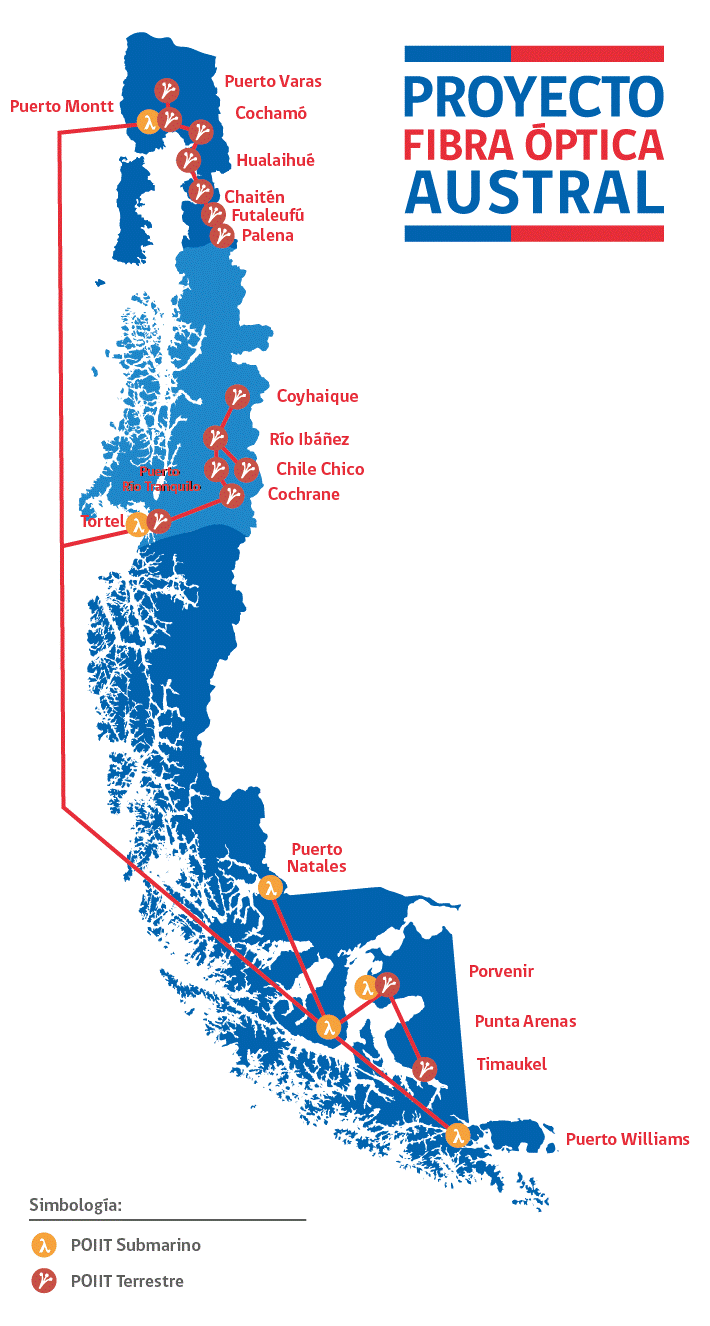|
Chilean teleco CTR, in association with Huawei Marine, has been awarded the contract for the submarine part and one of three terrestrial stretches of the much anticipated Fibra Austral, a fiber optic project to connect the far south of the country. Fibra Austral Cable Map Source: Telecomdrive Bureau
Of the US$100M available in subsidies, the company requested 52.691bn pesos (US$85M) to roll out 2,829km of submarine cable. The project consists of one stretch of submarine cable running from Puerto Montt to Puerto Williams with landings at Caleta Tortel and Punta Arenas and three stretches of terrestrial fiber running 1,000km. The submarine stretch consists of 60 optical channels (per fiber pair) and the Magallanes stretch, which CTR also won, consists of 40 optical channels (per fiber pair) connecting Puerto Natales and Porvenir. Two of the terrestrial stretches, Los Lagos and Aysén, were not awarded as offers did not meet technical criteria. Tenders for these two stretches will be launched in the next 60 days and are expected to be awarded before the end of the government of President Michelle Bachelet next March, Rodrigo Ramírez, head of telecoms regulator Subtel, told BNamericas. Four companies presented bids for the submarine cable project: Telefónica, which bid 53.5bn pesos (US$86M); CTR which bid 52.7bn pesos (US$85M); Austral Telco, an investment consortium put together by Chilean mobile operator WOM, which bid 52.7bn pesos (US$85M); and Canada's VuPoint Systems (Bid kept confidential). Ramírez said the winner had been chosen due to technical merit, the bid amount and the rates to be offered public institutions like municipalities, hospitals and schools for using the infrastructure, which in this case would be free of charge. Fibra Austral is part of a strategic plan to stimulate the local economy in remote areas and activities such as telemedicine and education. The government also expects the high bandwidth to facilitate connectivity for research stations in Antarctica and Chile's space research and satellite industry, and there are plans to eventually launch another tender to connect Chilean Antarctica to Puerto Williams. Satellites are increasingly being used to monitor irrigation and there is a need to connect terrestrial stations to fiber optic networks with large data capacity. Chile also has powerful telescopes in the north of the country which require huge amounts of bandwidth. Jorge Flies, governor of Magallanes region, told BNamericas that plans are already underway to build science and technology centers in Antarctica and Puerto Williams to download and relay data from some 600 satellites that are used for scientific research, specifically regarding climate change. The Swedish Space Corporation (SSC), currently offers hosting services in Santiago and Punta Arenas. Chile's traffic consumption is expected to reach 11.4 petabytes in 2020 compared to 4.3 petabytes in 2015, boosted largely by demand for video. Source: BNamericas ANALYSIS: It is not clear from this article whether Huawei Marine (HMN) partnered exclusively with CTR or whether they were allowed to be included in other bidders’ offers as the turnkey supplier of choice but it is likely that HMN represented the “golden bullet” for winning this tender. The Government of President Michelle Bachelet has been courting investment from China for some years. Discussions between the two countries have even taken place at a senior ministerial level about the feasibility of building an 18,000-km transpacific submarine fiber optic cable from Santiago, Chile to Hong Kong, PRC. In this environment, it is not surprising that Chinese majority-owned HMN is the appointed turnkey submarine system supplier. HMN has also recently benefited from the Chinese government’s desire to connect Africa to South America with the “SAIL” cable (Cameroon-Brazil), as part of its “One Belt, One Road” policy. With China Telecom looking set to acquire Brazilian fixed network operator, Oi, a Chile-HK cable would complete the “belt”. One other curious aspect of the above article from BNamericas is the projected annual demand in 2020 of 11.4 petabits of data for the entire Chilean market of 18 million people. Ignoring the fact that some of this demand will be satisfied internally, this figure implies a requirement for international capacity of only 361 megabits per second. For a population of this size today, the bandwidth demand is more likely to be in the tens of terabits per second by 2020.
0 Comments
Leave a Reply. |
Julian Rawle, AuthorThought leadership articles and commentary on developments related to the subsea fibre optic cable industry can be found here. Archives
February 2018
Categories |





 RSS Feed
RSS Feed